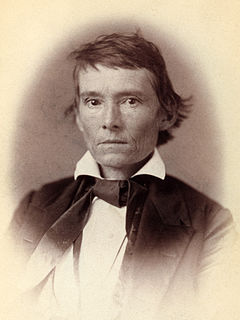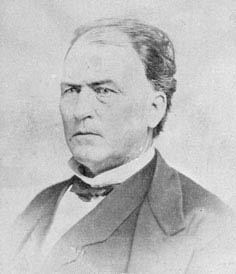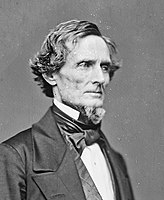
The Confederate States of America (CSA), commonly referred to as the Confederate States or the Confederacy, was an unrecognized breakaway state in existence from February 8, 1861, to May 9, 1865, that fought against the United States of America during the American Civil War. The eleven states that seceded from the Union and formed the main part of the CSA were South Carolina, Mississippi, Florida, Alabama, Georgia, Louisiana, Texas, Virginia, Arkansas, Tennessee, and North Carolina.

The Twelfth Amendment to the United States Constitution provides the procedure for electing the president and vice president. It replaced the procedure provided in Article II, Section 1, Clause 3, by which the Electoral College originally functioned. The amendment was proposed by the Congress on December 9, 1803, and was ratified by the requisite three-fourths of state legislatures on June 15, 1804. The new rules took effect for the 1804 presidential election and have governed all subsequent presidential elections.

The United States Electoral College is the group of presidential electors required by the Constitution to form every four years for the sole purpose of electing the president and vice president. Each state appoints electors according to its legislature, equal in number to its congressional delegation. Federal office holders cannot be electors. Of the current 538 electors, an absolute majority of 270 or more electoral votes is required to elect the president and vice president. If no candidate achieves an absolute majority there, a contingent election is held by the United States House of Representatives to elect the president, and by the United States Senate to elect the vice president.

This section of the Timeline of United States history concerns events from 1860 to 1899.

The Constitution of the Confederate States was the supreme law of the Confederate States of America. It was adopted on March 11, 1861, and was in effect from February 22, 1862, to the conclusion of the American Civil War. The Confederacy also operated under a Provisional Constitution from February 8, 1861, to February 22, 1862. The original Provisional Constitution is located at the American Civil War Museum in Richmond, Virginia, and differs slightly from the version later adopted. The final, handwritten Constitution is located in the University of Georgia archives. Most of its provisions are word-for-word duplicates from the United States Constitution; however, there are crucial differences between the two documents in tone and legal content, primarily regarding slavery.

Alexander Hamilton Stephens was an American politician who served as the vice president of the Confederate States from 1861 to 1865, and later as the 50th governor of Georgia from 1882 until his death in 1883. A member of the Democratic Party, he represented the state of Georgia in the United States House of Representatives before becoming governor.

The president of the Confederate States was the head of state and head of government of the Confederate States. The president was the chief executive of the federal government and was the commander-in-chief of the Confederate Army and the Confederate Navy.

The Confederate States Congress was both the provisional and permanent legislative assembly of the Confederate States of America that existed from 1861 to 1865. Its actions were for the most part concerned with measures to establish a new national government for the Southern "revolution", and to prosecute a war that had to be sustained throughout the existence of the Confederacy. At first, it met as a provisional congress both in Montgomery, Alabama and Richmond, Virginia.

The Provisional Congress of the Confederate States, also known as the Provisional Congress of the Confederate States of America, was a congress of deputies and delegates called together from the Southern States which became the governing body of the Provisional Government of the Confederate States from February 4, 1861, to February 17, 1862. It sat in Montgomery, Alabama, until May 21, 1861, when it adjourned to meet in Richmond, Virginia, on July 20, 1861. It added new members as other states seceded from the Union and directed the election on November 6, 1861, at which a permanent government was elected.
The Provisional Constitution of the Confederate States, formally the Constitution for the Provisional Government of the Confederate States of America, was an agreement among all seven original states in the Confederate States of America that served as its first constitution. Its drafting by a committee of twelve appointed by the Provisional Congress began on February 5, 1861. The Provisional Constitution was formally adopted on February 8. Government under this constitution was superseded by the new Constitution of the Confederate States with a permanent form of government "organized on the principles of the United States" on February 22, 1862.

Jesse David Bright was the ninth Lieutenant Governor of Indiana and U.S. Senator from Indiana who served as President pro tempore of the Senate on three occasions. He was the only senator from a Northern state to be expelled for being a Confederate sympathizer. As a leading Copperhead he opposed the Civil War.

Jackson Morton was an American politician. A member of the Whig Party, he represented Florida as a U.S. Senator from 1849 to 1855. He also served as a Deputy from Florida to the Provisional Congress of the Confederate States from 1861 to 1862.

Henry Cornelius Burnett was an American politician who served as a Confederate States Senator from Kentucky from 1862 to 1865. From 1855 to 1861, Burnett served four terms in the United States House of Representatives. A lawyer by profession, Burnett had held only one public office—circuit court clerk—before being elected to Congress. He represented Kentucky's 1st congressional district immediately prior to the Civil War. This district contained the entire Jackson Purchase region of the state, which was more sympathetic to the Confederate cause than any other area of Kentucky. Burnett promised the voters of his district that he would have President Abraham Lincoln arraigned for treason. Unionist newspaper editor George D. Prentice described Burnett as "a big, burly, loud-mouthed fellow who is forever raising points of order and objections, to embarrass the Republicans in the House".

The Vice-President of the Confederate States was the second highest executive officer of the government of the Confederate States of America and the deputy to the President of the Confederate States. The office was held by Alexander H. Stephens of Georgia, who served under President Jefferson Davis of Mississippi from February 18, 1861, until the dissolution of the Confederacy on May 5, 1865. Having first been elected by the Provisional Confederate States Congress, both were considered provisional office-holders until they won the presidential election of November 6, 1861 without opposition and inaugurated on February 22, 1862.

The Confederate States Secretary of War was a member of President Jefferson Davis's Cabinet during the American Civil War. The Secretary of War was head of the Confederate States Department of War. The position ended in May 1865 when the Confederacy crumbled during John C. Breckinridge's tenure of the office.
Charles Jacques Villeré was a Louisiana politician who served in the Congress of the Confederate States for two terms during the American Civil War. He was brother-in-law to P. G. T. Beauregard, whose first wife, Marie Antoinette Laure, was Villeré's sister.

The Confederate government of Kentucky was a shadow government established for the Commonwealth of Kentucky by a self-constituted group of Confederate sympathizers during the American Civil War. The shadow government never replaced the elected government in Frankfort, which had strong Union sympathies. Neither was it able to gain the whole support of Kentucky's citizens; its jurisdiction extended only as far as Confederate battle lines in the Commonwealth. Nevertheless, the provisional government was recognized by the Confederate States of America, and Kentucky was admitted to the Confederacy on December 10, 1861. Kentucky, the final state admitted to the Confederacy, was represented by the 13th (central) star on the Confederate battle flag.

The military forces of the Confederate States, also known as Confederate forces, were the military services responsible for the defense of the Confederate States during its brief existence (1861–1865).

There are several works of art in the United States Capitol honoring former leaders of the Confederate States of America and generals in the Confederate States Army, including eight statues in the National Statuary Hall Collection, busts and portraits.















